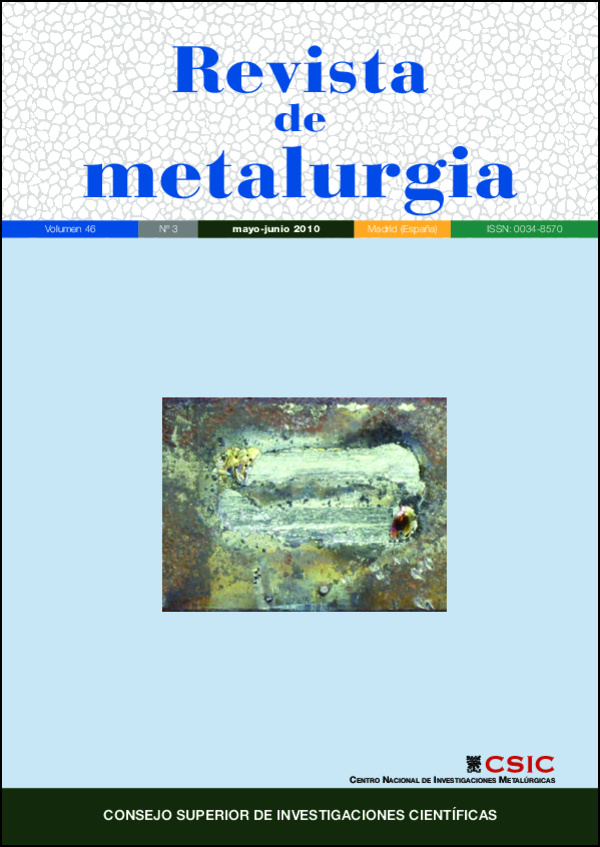Microstructural evolution of SiC/Cu-Si composites obtained through reactive infiltration
DOI:
https://doi.org/10.3989/revmetalm.0942Keywords:
Reactive infiltration, Decomposition SiC, Composite SiC/Cu, MicroestructureAbstract
The microstructural evolution of composites of SiC/Cu-Si alloys obtained through process of reactive infiltration to 1400 °C was studied. Three zones were detected in the obtained composites: the reaction zone, the transition zone and the infiltrated zone. In the reaction zone and transition zone the resulting microstructure was composed of a metallic phase, graphite laminae and SiC particles. It was found that SiC decomposes into these areas because of the alloy Cu-Si, so the available Si forms a liquid solution that a room temperature consisted of a α solid solution and a γ phase (Cu5Si). The carbon resulting from the decomposition of SiC precipitated as graphite laminae. In addition, the SiC decomposition was decreasing as the initial amount of Si in the alloy increased.
Downloads
References
[1] C. D. Qin y B. Derby, British. Cer. Trans. J. 90 (1991) 124-125.
[2] A. M. Davidson y D. Regener, Compos. Sci. Technol. 60 (2000) 865-869. doi:10.1016/S0266-3538(99)00151-7
[3] A. Brendel, C. Popescu y C. Leyens, J. Nucl. Mater. 329-333 (2004) 804-808. doi:10.1016/j.jnucmat.2004.04.304
[4] K. M. Shu y G. C. Tu, Mat. Sci. Eng. A 349 (2003) 236-247. doi:10.1016/S0921-5093(02)00788-8
[5] G. Sundberg, P. Paul, C. Sung y T. Vacilos, J. Mater. Sci. 41 (2003) 236-247.
[6] S. Ordoñez, V. Martínez, F. Castro, L. Olivares y J.Marín, J.Mater. Sci. 38 (2003) 4.047-4.054.
[7] J. Cornejo, Tésis Magister, Facultad de Ingeniería, Universidad de Santiago de Chile, 2005.
[8] C. Rado, B. Drevet y N. Eustathopoulos, Acta Mater. 48 (2000) 4.483-4.491.
[9] H. Sakao y J. Elliot, Metall. Trans. 5 (1974) 2.036.
[10] C. Rado, S. Kalogeropoulou y N. Eustathopoulos, Mat. Sci. Eng. A 276 (2000)195-202. doi:10.1016/S0921-5093(99)00274-9
[11] K. Gan, M.Y. Gu y G. Mu, J. Mater. Sci. 43 (2008) 1.318-1.323.
[12] C. Rado y N. Eustathopoulos, Interface Sci. 12 (2004) 85-92. doi:10.1023/B:INTS.0000012297.30968.02
[13] K. Landry, C. Rado y N. Eustathopoulos,Metall. Mater.Trans. 27A (1996) 3.181-3.186.
[14] M. Song y B. Huang, Mat. Sci. Eng A 488 (2008) 601-607. doi:10.1016/j.msea.2008.03.022
[15] Smithells y Colin J., Metal Reference Book, Vol. II, Ed. Elseiver Inc., 4ª Ed., Oxford, Inglaterra, 1967, pp. 11-264.
[16] Y. Naidich, Prog. Surf.Membrane Sci. 14 (1981) 353.
[17] I. Aksay, C. Hoge, y J. Pask, J.Phys. Chem. 78 (1974) 1.178.
[18] R. German, PowderMetallurgy Science, 2nd Ed., College Road East., Princeton, New Jersey, EE. UU., 1994, pp. 15-120.
[19] J.D. Verhoeven, Fundamentals of Physical Metallurgy, Ed. JohnWiley&Sons, Nueva York, EE. UU., 1975, pp.
Downloads
Published
How to Cite
Issue
Section
License
Copyright (c) 2010 Consejo Superior de Investigaciones Científicas (CSIC)

This work is licensed under a Creative Commons Attribution 4.0 International License.
© CSIC. Manuscripts published in both the printed and online versions of this Journal are the property of Consejo Superior de Investigaciones Científicas, and quoting this source is a requirement for any partial or full reproduction.
All contents of this electronic edition, except where otherwise noted, are distributed under a “Creative Commons Attribution 4.0 International” (CC BY 4.0) License. You may read the basic information and the legal text of the license. The indication of the CC BY 4.0 License must be expressly stated in this way when necessary.
Self-archiving in repositories, personal webpages or similar, of any version other than the published by the Editor, is not allowed.
















